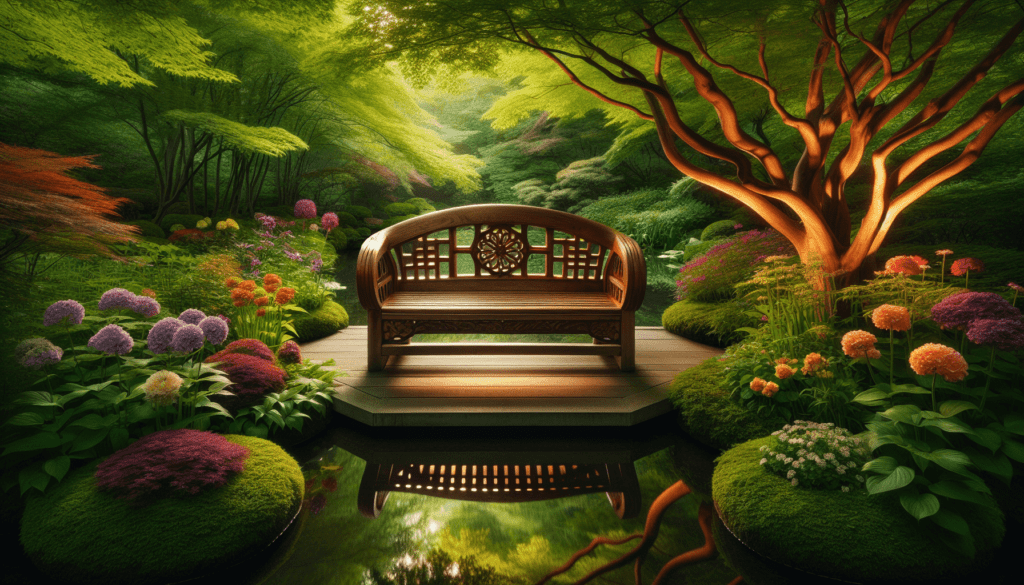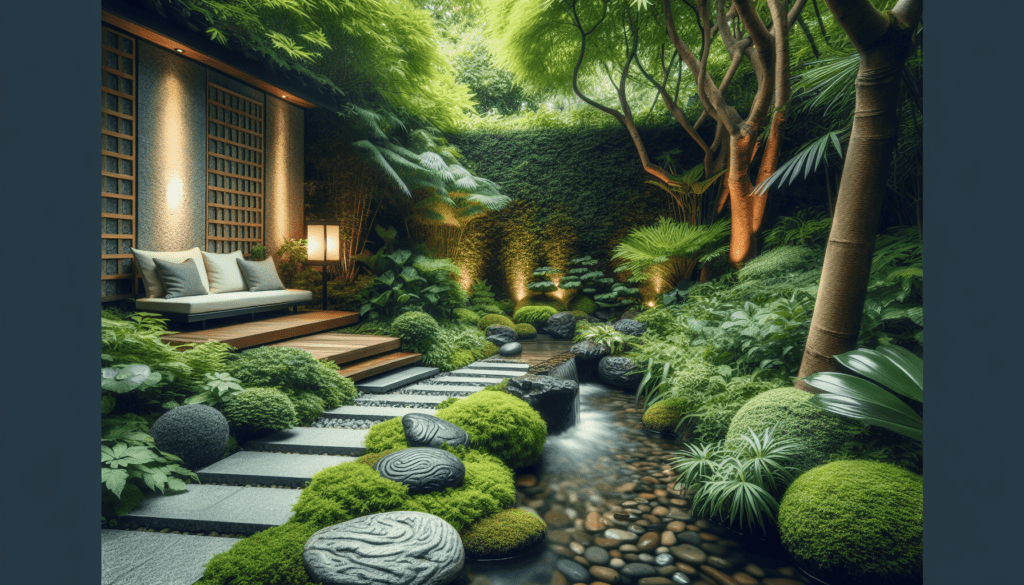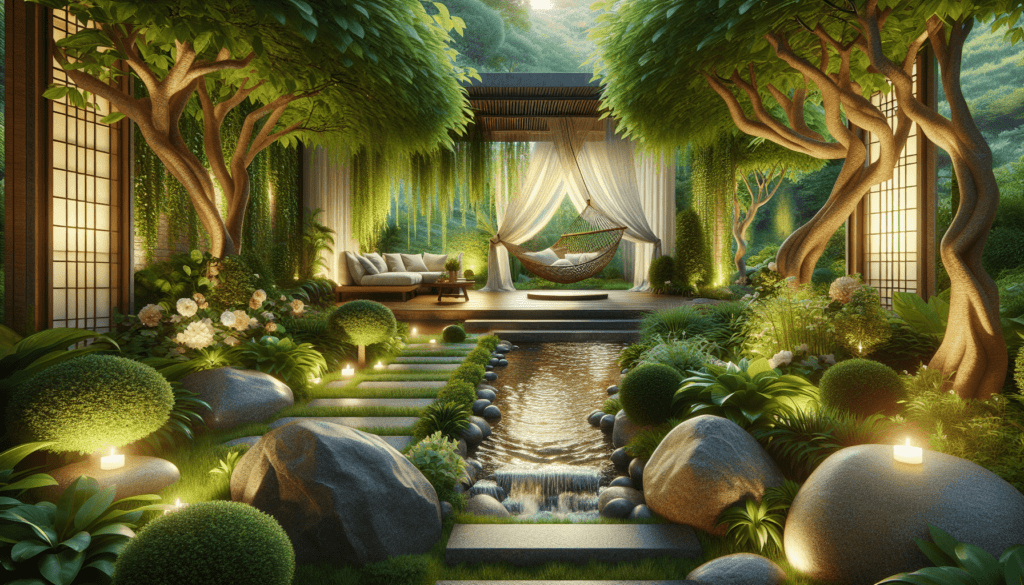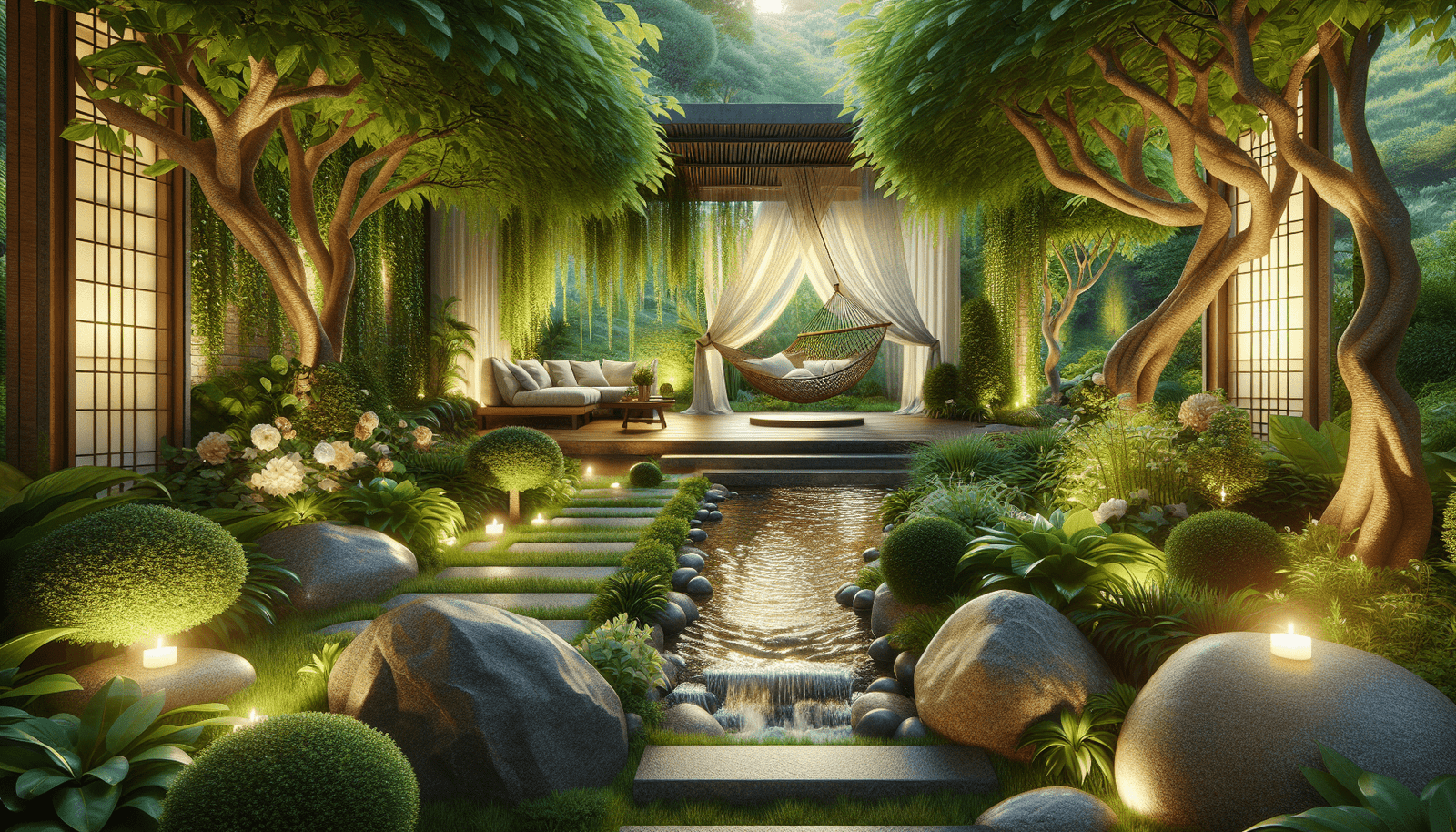Imagine stepping into a lush oasis right outside your door, where the gentle breeze carries the soothing melodies of chirping birds and the scent of blooming flowers fills the air. It’s a haven, carefully designed to foster relaxation and mindfulness, providing an escape from the hustle and bustle of everyday life. Creating a garden that embraces these qualities not only enhances the beauty of your outdoor space but also helps to cultivate a sense of peace and tranquility within yourself. In this article, we will explore the key elements and considerations involved in designing a garden that serves as a sanctuary for relaxation and mindfulness. So, sit back, let your mind wander, and let nature work its magic.
Choosing the Right Location
Consider the size of your garden
When designing a garden for relaxation and mindfulness, it’s important to consider the size of your garden. If you have a small garden, you’ll need to make the most of the space you have. Consider using vertical gardening techniques to maximize your planting areas. If you have a larger garden, take advantage of the extra space by creating separate areas for different activities, such as a designated seating area and a meditation corner.
Evaluate the amount of sunlight and shade
The amount of sunlight and shade in your garden can greatly impact the atmosphere and the types of plants you can grow. Some plants require full sun, while others thrive in shade. Evaluate your garden’s exposure to sunlight throughout the day to determine which areas receive the most sun and which are shaded. This will help you determine the appropriate plants for each area and also guide you in placing seating areas and other features in the ideal spots.
Assess the noise levels and privacy
In order to create a tranquil garden, it’s important to assess the noise levels and privacy of your outdoor space. Consider if your garden is exposed to excessive noise from nearby roads or neighbors. If so, you may want to incorporate sound-blocking features like tall plants or a water fountain. Additionally, assessing the privacy of your garden will help you decide if you need to include privacy screens or fencing to create a more secluded and peaceful environment.
Creating a Tranquil Layout
Design a focal point
When designing a garden for relaxation, it’s important to create a focal point that draws your attention and provides a sense of calm. This could be a beautiful flower bed, a sculptural tree, or a soothing water feature. The focal point should be positioned in a way that it can be easily seen from different parts of the garden, serving as a visual anchor that grounds the space and encourages mindful observation.
Incorporate pathways for relaxation
Pathways are not only functional but can also contribute to the overall tranquility of your garden. By incorporating pathways made of gravel, stone, or wood, you can create a sense of rhythm and flow. These paths can lead you through different areas of the garden, guiding your footsteps and inviting you to slow down and take in the beauty of your surroundings.
Include comfortable seating areas
To truly relax and unwind in your garden, it’s important to have comfortable seating areas where you can sit and enjoy the peace and serenity of nature. Consider incorporating a variety of seating options, such as a cozy bench, reclining loungers, or even a hammock. Choose durable and weather-resistant materials that will withstand the outdoor elements and provide a comfortable place to rest and reflect.

Selecting Calming Plants
Choose plants with soft textures
When creating a garden for relaxation, it’s important to choose plants with soft textures that invite touch and create a soothing sensory experience. Look for plants with soft leaves, velvety petals, or feathery foliage. Incorporate herbs like lamb’s ear or ornamental grasses with their soft and tactile qualities. The gentle touch of these plants can evoke a sense of tranquility and help you connect with nature at a deeper level.
Opt for plants with soothing scents
Adding plants with soothing scents to your garden can enhance the mindfulness experience. Consider planting aromatic herbs like lavender, rosemary, or chamomile. These plants release pleasant fragrances that promote relaxation and have been used for centuries in aromatherapy practices. Brushing against these plants or simply breathing in their scent can create a calming atmosphere and help you find inner peace.
Include plants with calming colors
The colors in your garden can greatly impact your mood and contribute to a sense of tranquility. Opt for plants with calming colors like soft blues, lavenders, whites, and pastel pinks. These hues have a calming effect on the mind and can create a serene and peaceful ambiance. Mix different plants with complementary colors to create a harmonious and aesthetically pleasing palette throughout your garden.
Adding Water Features
Install a zen-like water fountain
Water features are excellent additions to a relaxation garden, as they provide both visual and auditory tranquility. Consider installing a zen-like water fountain, which can serve as a focal point and create a soothing soundscape. The gentle flow of water can be mesmerizing and help drown out any distracting noises from your surroundings, allowing you to fully immerse yourself in the present moment.
Consider a small pond or water garden
For a more immersive water experience, consider adding a small pond or water garden to your outdoor space. The sight of water plants floating peacefully and the sound of water trickling create a sense of serenity. You can even incorporate fish or other aquatic animals to further enhance the natural beauty and bring a sense of serenity to your garden.
Include a gentle waterfall or stream
If you have space and the inclination, including a gentle waterfall or stream can add a touch of tranquility to your garden. The sound of water cascading over rocks or gently flowing through a stream can be incredibly soothing. Situating this feature near a seating area will allow you to fully appreciate the calming effects as you relax and unwind in your garden.

Implementing Aromatherapy Elements
Plant aromatic herbs like lavender and rosemary
Incorporating aromatherapy elements into your garden can further enhance the relaxation experience. Plant aromatic herbs like lavender and rosemary, which not only add beauty to your garden but also release delightful scents that have a calming effect on the mind. These herbs can be used in various ways, from brewing a cup of herbal tea to creating homemade potpourri, allowing you to fully immerse yourself in the therapeutic benefits of these plants.
Use scented candles or essential oil diffusers
To enhance the sensory experience, consider adding scented candles or using essential oil diffusers in your garden. Set the mood with the gentle flickering of candles and the calming aroma of natural scents like lavender, chamomile, or eucalyptus. These scents can promote relaxation, reduce stress, and create a peaceful environment for mindfulness practices.
Create a space for growing fragrant flowers
Fragrant flowers not only add beauty to your garden but also fill the air with captivating scents. Create a dedicated space for growing fragrant flowers like roses, jasmine, or honeysuckle. These flowers release intoxicating aromas that can transport you to a state of tranquility and bliss. Incorporate them into your garden beds or plant them near seating areas, where their scents can enchant and captivate your senses.
Designing for Privacy
Install privacy screens or fencing
Privacy is essential for creating a tranquil garden that allows you to fully relax and unwind. Install privacy screens or fencing to create a more secluded and intimate space. This will block unwanted views from neighboring properties and create a sense of enclosure. Choose materials that match your garden’s aesthetic, such as wooden slats or tall hedges, to ensure both functionality and visual appeal.
Incorporate tall plants or trees as natural barriers
If privacy screens or fencing are not feasible options, you can incorporate tall plants or trees as natural barriers. Strategically plant trees, shrubs, or bamboo along the edges of your garden to create a green and lush boundary that provides privacy and seclusion. These natural barriers not only offer privacy but also enhance the overall aesthetics of your garden by adding texture and height variations.
Create hidden nooks or secluded areas
For ultimate privacy, consider creating hidden nooks or secluded areas within your garden. These intimate spaces can be tucked away behind tall plants, nestled within a lush corner, or shielded by privacy screens. Design seating areas, meditation spots, or reading nooks within these areas, providing a sense of solace and tranquility away from prying eyes and external distractions.

Adding Texture and Visual Interest
Use a mix of different plant heights and shapes
To create visual interest and a sense of depth, use a mix of different plant heights and shapes in your garden. Incorporate tall plants like ornamental grasses or flowering shrubs, medium-sized plants like perennials or small trees, and low-growing plants like groundcovers or creeping vines. By layering different plant heights, you can create a three-dimensional effect that adds visual appeal and creates a sense of depth and harmony in your garden.
Incorporate various materials like stones, wood, or gravel
In addition to plants, incorporating various materials can add texture and visual interest to your garden. Use stones, wood, or gravel to create pathways, borders, or seating areas. These materials can provide contrast and add a sense of structure and balance to your garden design. Carefully choose the colors and textures of these materials to complement the overall aesthetic and create a harmonious and inviting space.
Add interesting sculptures or art pieces
To truly personalize your garden and make it a reflection of your own unique style, consider adding interesting sculptures or art pieces. These can serve as focal points or hidden treasures within your garden, adding a sense of intrigue and creativity. Choose sculptures or art pieces that resonate with you and evoke a sense of tranquility or inspiration, creating a garden that is not only visually appealing but also deeply meaningful.
Including Sensory Elements
Create areas for touch and tactile experiences
Incorporating areas for touch and tactile experiences can deepen your connection with nature and enhance the sensory journey within your garden. Consider adding plants with different textures, like soft leaves, fuzzy stems, or prickly foliage. Install a sensory path made of different materials, such as smooth stones, gravel, or moss, that allows you to explore different sensations under your feet. These tactile experiences can awaken your senses and promote mindfulness as you engage with your garden.
Incorporate wind chimes or gentle sound-producing objects
The soothing sounds of wind chimes or gentle sound-producing objects can create a serene atmosphere in your garden. Hang wind chimes near seating areas or along pathways where they can sway with the breeze and produce calming melodies. Whether it’s the tinkling of chimes or the gentle rustling of bamboo, these sounds can transport you to a state of tranquility and help you find inner peace and relaxation.
Include plants that attract butterflies or birds
Inviting nature into your garden by including plants that attract butterflies or birds can add an extra layer of sensory delight. Choose plants that provide food, shelter, or nesting opportunities for these creatures. The vibrant colors and graceful movements of butterflies or the melodious songs and lively antics of birds can captivate your attention, bringing joy and a sense of harmony to your garden.

Designing for Year-round Enjoyment
Choose plants with different blooming seasons
To ensure year-round enjoyment in your garden, it’s important to choose plants with different blooming seasons. This will allow you to have a continuous display of colors and fragrances throughout the year, providing visual interest and sensory delight in every season. Incorporate early spring bulbs, summer annuals, fall-blooming perennials, and evergreen plants that thrive in winter. With careful planning, you can enjoy the beauty and serenity of your garden year-round.
Include evergreen plants for year-round foliage
In addition to seasonal blooms, including evergreen plants in your garden ensures that you have foliage and structure year-round. Evergreen trees, shrubs, or groundcovers add depth and vibrancy to your garden, even during the colder months when other plants may go dormant. Choose varieties with different shapes and textures to create an interesting and visually pleasing display throughout the year.
Utilize outdoor heaters or fire pits for colder months
To extend the usability of your garden during colder months, consider utilizing outdoor heaters or fire pits. These features provide warmth and create a cozy atmosphere that allows you to continue enjoying your garden even in chilly weather. Wrap yourself in a blanket and sit by the fire, surrounded by the sights and sounds of your tranquil garden. The crackling flames and the glow of the fire will create a comforting ambiance that promotes relaxation and mindfulness.
Creating a Balanced Environment
Ensure a proper balance of sun and shade areas
To create a balanced and harmonious environment in your garden, it’s important to ensure a proper balance of sun and shade areas. Some plants thrive in full sun, while others prefer partial shade or full shade. By understanding the sunlight requirements of your chosen plants, you can strategically place them in areas that provide the ideal light conditions. This balance will not only promote healthy plant growth but also create a visually pleasing and dynamic garden.
Incorporate elements that promote relaxation and stimulation
A garden designed for relaxation and mindfulness should have elements that promote both relaxation and stimulation. Balance quiet and contemplative areas with spaces that encourage movement and activity. For example, incorporate a serene seating area for meditation or reading, but also include a space for yoga or gentle exercise. This balance allows you to cater to different moods and activities, supporting your overall well-being.
Design for both solitude and social interaction
Lastly, when designing your garden for relaxation and mindfulness, it’s important to create spaces for both solitude and social interaction. Include secluded nooks or hidden corners where you can retreat for quiet contemplation and reflection. At the same time, design areas for social interaction, such as a gathering space with a fire pit or a dining area for hosting friends and family. Striking a balance between solitary and social spaces will ensure that your garden can accommodate different needs and foster a sense of connection and tranquility.
In conclusion, designing a garden for relaxation and mindfulness requires careful consideration of the location, layout, plants, and elements that contribute to a tranquil and serene atmosphere. By assessing the size, sunlight, noise levels, and privacy of your garden, you can create a space that is conducive to relaxation and mindfulness. Incorporating focal points, pathways, comfortable seating areas, and water features adds to the overall tranquility. Selecting plants with soft textures, soothing scents, and calming colors enhances the sensory experience. By implementing aromatherapy elements, designing for privacy, adding texture and visual interest, including sensory elements, and considering year-round enjoyment, you can create a garden that promotes relaxation, mindfulness, and a deep connection with nature. Remember to create a balanced environment that caters to both solitude and social interaction, ensuring that your garden provides a haven of tranquility for your own well-being and that of others. So, get started on designing your own relaxation garden and immerse yourself in the serenity and peace it brings.

